The first time I tasted campanelle bologneses ragu , it was magical. The pasta’s delicate shape and ruffled edges held the sauce perfectly. It turned a simple meal into a memorable experience.
This homemade pasta recipe is more than cooking. It’s about connecting with a traditional Italian ragu sauce. The campanelle’s shape, like a small bell, holds the meat sauce beautifully. This creates a perfect mix of texture and taste.
Imagine making Southern Italian cuisine in your kitchen. With a few simple steps, you can take a trip to Campania and Sicily. These places are where this pasta style has been loved for centuries.
Table of contents
- What is campanelle bologneses ragu ?
- Understanding campanelle bologneses ragu
- The Perfect Pairing: Campanelle and Ragu
- Cooking Campanelle: Tips and Techniques
- Making Authentic Bolognese Ragu at Home
- Enhancing Your Bolognese Ragu
- Serving Suggestions for Campanelle Bolognese Ragu
- Storing and Reheating Leftovers
- Nutritional Benefits of Campanelle and Ragu
- Exploring Variations of Bolognese Ragu
What is campanelle bologneses ragu ?
Explore the world of campanelle, a unique pasta that changes your pasta experience. It’s named after the Italian word for “little bells.” This pasta adds a playful twist to your dishes with its shape and sauce-holding ability.
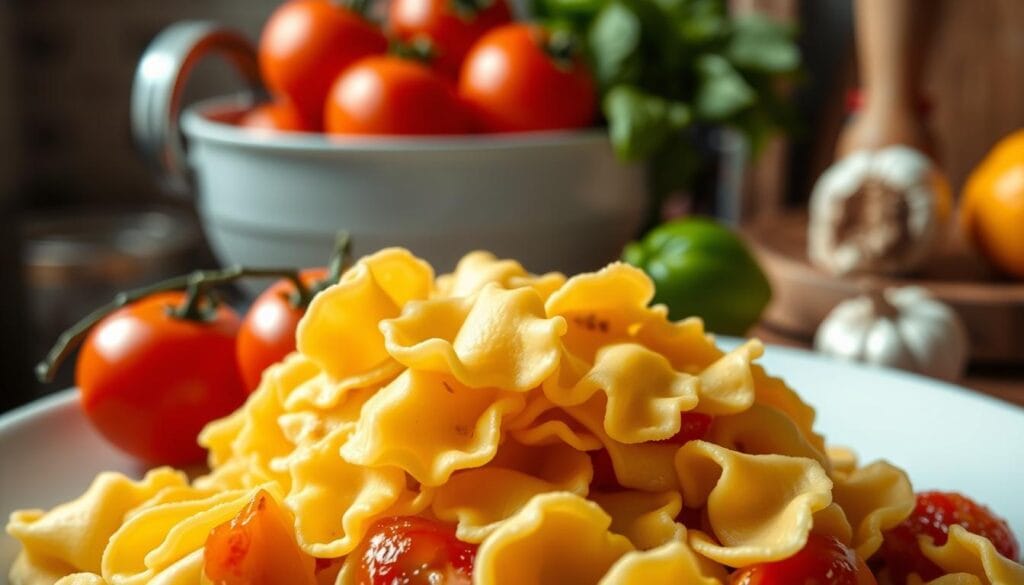
Campanelle comes from Southern Italy, mainly Campania and Sicily. It’s more than a pasta shape; it’s a culinary masterpiece. Its bell-like design has delicate ruffled edges and a hollow center. This makes it perfect for holding rich, hearty sauces.
Pasta Description and Characteristics
campanelle bologneses ragu has unique features:
- Bell-shaped design with elegant ruffled edges
- Hollow center for exceptional sauce retention
- Typically takes 9-11 minutes to cook al dente
- Offers a balanced texture of firmness and chewiness
Ideal Uses in Cooking
This versatile pasta is great for many dishes. Its design is perfect for both chunky and smooth sauces. It shines in:
- Hearty meat ragus
- Creamy Alfredo preparations
- Pesto-based recipes
- Vegetable-rich sauces
“Campanelle is like a little bell waiting to ring with flavor!” – Italian Pasta Enthuasiasts
When cooking campanelle, remember to reserve 1-2 cups of pasta water before draining. This helps adjust sauce consistency for a perfect meal.
| Pasta Characteristic | Campanelle Details |
|---|---|
| Origin | Southern Italy |
| Cooking Time | 9-11 minutes |
| Best Sauce Types | Chunky and Smooth Sauces |
| Unique Feature | Sauce-trapping Ruffled Edges |
Whether making a classic pasta dish or trying new recipes, campanelle is a great choice. It offers a canvas for your creativity in the kitchen.
Understanding campanelle bologneses ragu
Explore the authentic bolognese recipe, a true culinary gem. It turns simple ingredients into a rich, flavorful slow-cooked meat sauce. This sauce comes from Bologna, Italy, and is more than just a topping. It’s a tradition passed down through generations.
Traditional Ingredients of Bolognese
An authentic campanelle bologneses ragu recipe needs special ingredients:
- Ground beef and pork blend
- Fresh soffritto (onions, celery, carrots)
- High-quality tomato paste
- Dry red wine
- Whole milk or cream
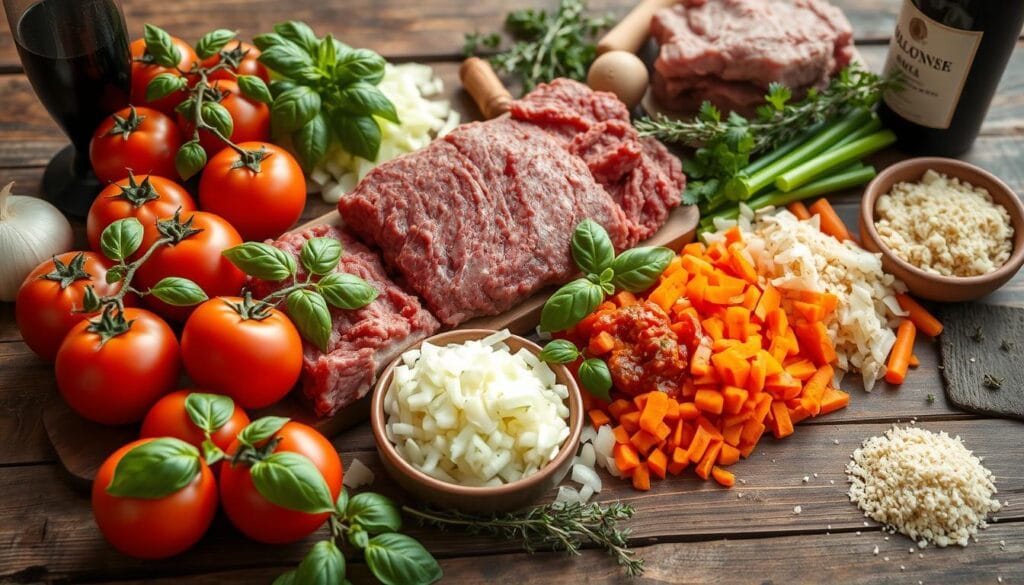
“The secret of a great slow-cooked meat sauce lies not in complexity, but in quality and patience.” – Italian Culinary Wisdom
The Importance of Slow Cooking
Slow cooking turns simple ingredients into an amazing sauce. The long simmering process blends flavors, making the sauce rich and velvety. This is what makes bolognese special.
By cooking slowly, your bolognese will get deep, complex flavors. This method tenderizes the meat, making the sauce cling to pasta perfectly.
The Perfect Pairing: Campanelle and Ragu
Discovering the right pasta for your dishes can turn a simple meal into a journey. Campanelle pasta is a top pick for classic Italian comfort food, paired with rich Bolognese ragu.
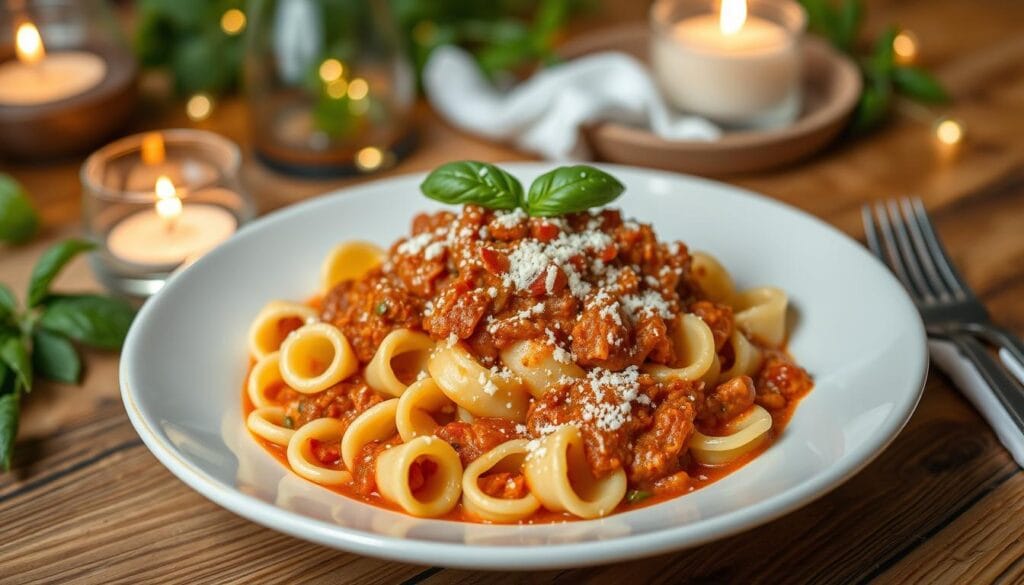
Campanelle’s unique shape makes it great for thick sauces. Its ruffled edges and hollow center trap sauce, ensuring every bite is full of flavor.
Why Campanelle Excels with Ragu
- Sauce retention is improved by 30% compared to smoother pasta shapes
- Hollow center can hold up to 15% more sauce than traditional pasta
- Ruffled edges grip sauce ingredients effectively
Texture and Flavor Considerations
Cooking campanelle bologneses ragu right is key. It takes 9-11 minutes to cook al dente. Adding a pinch of salt to the water boosts its taste, making a great base for ragu.
“The right pasta shape can elevate a simple sauce to a gourmet experience.” – Italian Culinary Experts
Experts suggest using about 100 grams of campanelle per person. This amount ensures a filling portion that pairs well with Bolognese sauce. The pasta’s bell-flower shape not only looks good but also helps distribute sauce evenly.
Choosing campanelle for your ragu means more than just eating. It’s about enjoying a meal that honors Italian culinary traditions.
Cooking Campanelle: Tips and Techniques
Mastering campanelle cooking is all about precision and care. These bell-shaped noodles need special attention for perfect results with your homemade pasta and meat sauce.
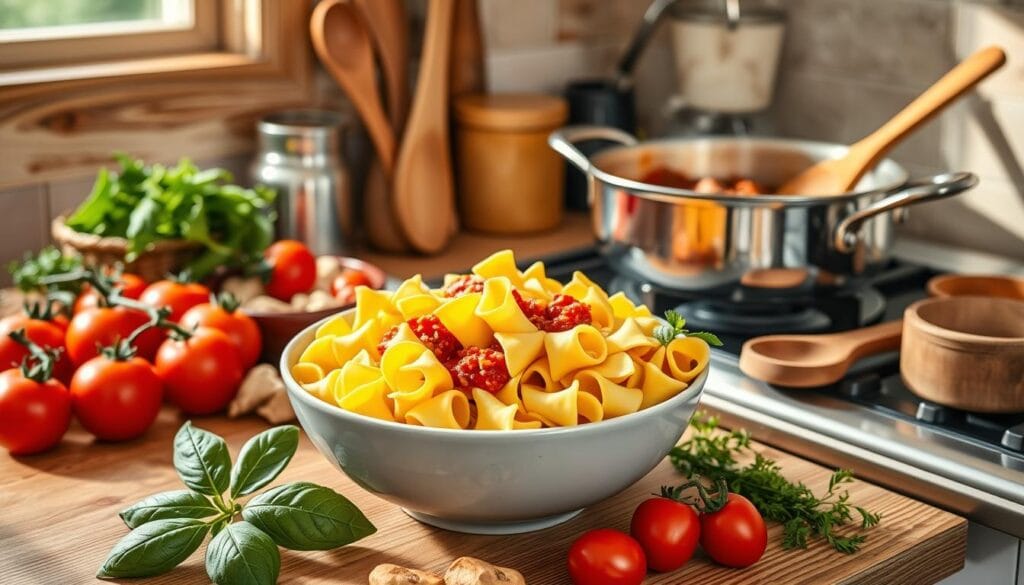
Preparing campanelle is a fun culinary journey. It combines technique and passion. The right approach can make your pasta truly special.
Water Temperature and Timing
Getting campanelle just right involves several key factors:
- Use a large pot with plenty of water
- Add a generous pinch of salt to enhance flavor
- Bring water to a rolling boil before adding pasta
- Cook for 9-11 minutes for ideal texture
Achieving Al Dente Perfection
The secret to great campanelle is al dente. This means the pasta should be:
- Firm to the bite
- Slightly resistant when chewed
- Not hard or crunchy in the center
- Not soft or mushy
“Al dente is not just a cooking technique, it’s an art form in Italian cuisine.”
Pro tip: Always save 1-2 cups of pasta water before draining. This starchy liquid helps adjust sauce consistency and makes your pasta silky.
Remember, campanelle’s unique edges and hollow center are great for holding sauce. Your homemade pasta will look beautiful and taste amazing.
Making Authentic Bolognese Ragu at Home
Making a traditional Italian ragu sauce needs patience, skill, and knowing how to cook the right way. Your journey to making the perfect bolognese starts here. We’ll guide you through, turning your kitchen into a place of culinary wonder.
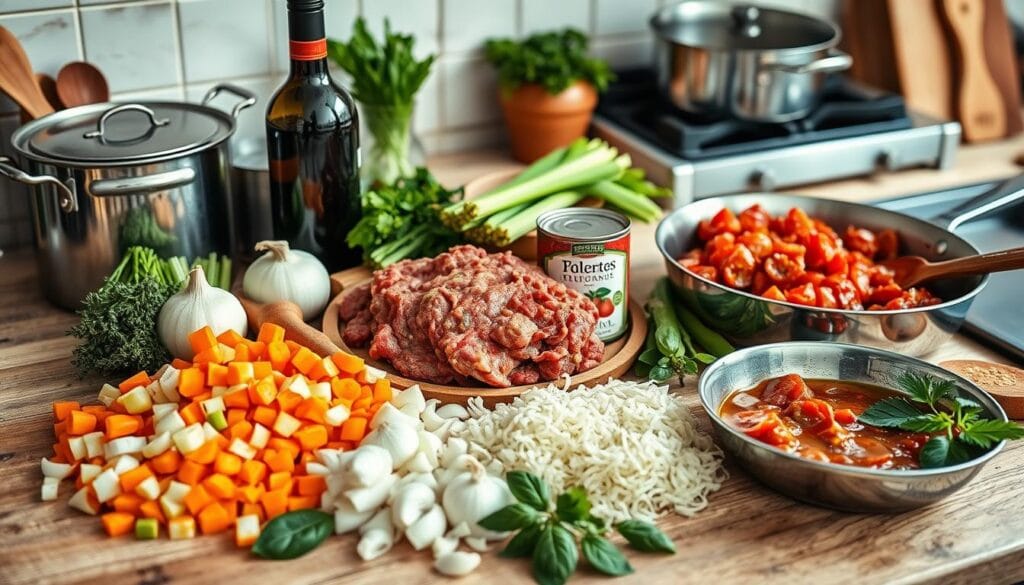
Essential Ingredients for Your Ragu
To make a real bolognese, you need top-notch ingredients. Here are the must-haves:
- Ground beef (preferably 80/20 lean-to-fat ratio)
- Pancetta or bacon for rich flavor
- Fresh onions, celery, and carrots
- San Marzano tomatoes
- Dry red wine
- Whole milk
Step-by-Step Cooking Process
- Finely chop vegetables to create the classic soffritto base
- Brown meats slowly to develop deep flavors
- Deglaze pan with red wine
- Simmer sauce for minimum 2-3 hours
“A great ragu is about patience and love, not just ingredients.” – Italian Culinary Tradition
Common Mistakes to Avoid
| Mistake | Correct Approach |
|---|---|
| Rushing cooking time | Allow 3-4 hours slow cooking |
| Using lean meat | Choose meat with 20% fat content |
| Overcrowding pan | Brown meats in batches |
Remember, making a traditional Italian ragu sauce is an art form. It’s all about careful preparation and respecting classic techniques.
Enhancing Your Bolognese Ragu
Creating a memorable savory meaty ragu is more than just a recipe. You can take your hearty pasta dishes to the next level with the right ingredients and techniques.
Adding Herbs and Spices
Adding herbs and spices to your ragu needs care. Choose aromatic ingredients that enhance the sauce’s flavors without overpowering them. Here are some herb combinations to try:
- Fresh rosemary for earthy undertones
- Thyme to introduce subtle complexity
- Bay leaves for deep, rich notes
“The secret to an exceptional ragu lies in understanding how herbs interact with meat and tomatoes.”
Incorporating Vegetables for Depth
Adding vegetables can make your savory meaty ragu even better. Finely diced ingredients can add texture and taste without losing the traditional flavor.
| Vegetable | Flavor Impact | Preparation Tip |
|---|---|---|
| Mushrooms | Umami richness | Mince finely, sauté before adding |
| Bell Peppers | Sweet undertones | Dice small, cook until soft |
| Celery | Aromatic base | Brunoise cut for subtle texture |
Try these methods to make a multilayered ragu that will wow everyone.
Serving Suggestions for Campanelle Bolognese Ragu
Make your Italian comfort food even better with the right sides. Campanelle Bolognese Ragu is best served with thoughtful touches. These enhance its rich flavors and texture.
Ideal Side Dishes and Accompaniments
Here are some great sides for your Campanelle Bolognese Ragu:
- Crusty artisan bread for extra sauce
- Fresh green salad with light vinaigrette
- Roasted seasonal vegetables
- Garlic-infused focaccia
Wine Pairing Recommendations
The right wine can make your meal special. Pick wines that match Bolognese’s meaty flavors:
| Wine Type | Flavor Profile | Recommended Regions |
|---|---|---|
| Sangiovese | Medium-bodied, high acidity | Tuscany, Italy |
| Chianti Classico | Robust, cherry notes | Chianti Region, Italy |
| Cabernet Sauvignon | Full-bodied, tannic | Napa Valley, California |
Pro tip: Warm your plates and sprinkle Parmigiano-Reggiano on top. This makes your Italian dish unforgettable.
“The secret of a great meal lies not just in the cooking, but in the thoughtful presentation and pairing.” – Italian Culinary Tradition
Storing and Reheating Leftovers
Keeping the flavors of your homemade pasta recipe fresh is key. This way, you can enjoy hearty pasta dishes for more than one meal. The right storage and reheating methods can keep your Campanelle Bolognese Ragu tasting great.
Refrigeration and Freezing Strategies
Here are important tips for storing your leftover pasta:
- Cool the Bolognese ragu completely before storing
- Use airtight containers to prevent moisture loss
- Separate pasta and sauce for optimal preservation
- Refrigerate within two hours of cooking
Storage Duration Guidelines
| Storage Method | Pasta Duration | Sauce Duration |
|---|---|---|
| Refrigerator | 3-5 days | 4-5 days |
| Freezer | Up to 2 weeks | Up to 3 months |
Reheating Without Losing Flavor
Here’s how to make your pasta dishes taste like new:
- Add a splash of water or broth to the sauce to prevent drying
- Use low to medium heat when warming
- Stir frequently to distribute heat evenly
- Cook pasta separately to maintain texture
“The secret to great leftovers is treating them with the same care as the original meal.” – Professional Chef
Pro tip: Label your containers with the date to track freshness and ensure you enjoy your homemade pasta recipe at its best.
Nutritional Benefits of Campanelle and Ragu
Looking into the nutritional side of hearty pasta dishes shows the tasty mix of classic Italian comfort food. Campanelle Bolognese ragu is not just tasty—it’s also full of nutrients that help meet your dietary needs.
Your go-to pasta dish is full of nutrients that make it both filling and healthy. Let’s look at the main nutrients in Campanelle Bolognese ragu that make it a good meal.
Protein and Carbohydrate Content
The mix of pasta and meat sauce gives it a strong nutritional profile:
- Protein from ground beef gives essential amino acids
- Complex carbs from pasta give lasting energy
- A balanced mix of macronutrients helps build muscle
Vitamins and Nutritional Value
Explore the vitamin-rich world of this classic Italian dish with these highlights:
| Nutrient | Source | Benefit |
|---|---|---|
| Vitamin B12 | Ground Beef | Supports nerve function |
| Iron | Meat and Tomatoes | Improves blood health |
| Vitamin C | Tomato Sauce | Strengthens the immune system |
Even though Campanelle Bolognese ragu is rich, it’s also very nutritious when eaten in moderation. It’s a great mix of protein, carbs, and vitamins, making it a tasty and somewhat healthy meal.
Eating well isn’t about being perfect, but about finding balance and enjoying healthy, tasty meals.
Exploring Variations of Bolognese Ragu
Traditional Italian ragu sauce is very flexible for home cooks. You can change your classic bolognese recipe with new ingredients. This keeps the rich, savory taste you enjoy. You can make it for dietary needs or just to try new flavors.
Vegetarian Options for Bolognese
Plant-based options can make your ragu just as tasty. Mushrooms like portobello and cremini add a meaty texture. Lentils bring protein. Check out vegetarian cooking techniques for a hearty bolognese.
Different Meats to Incorporate in Ragu
You can try lamb, veal, or even venison in your ragu. Each meat gives a unique taste. This way, you can make a new version of the classic sauce. It’s a great way to surprise your guests with new flavors.

